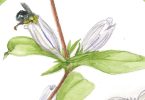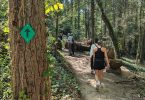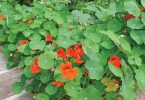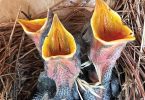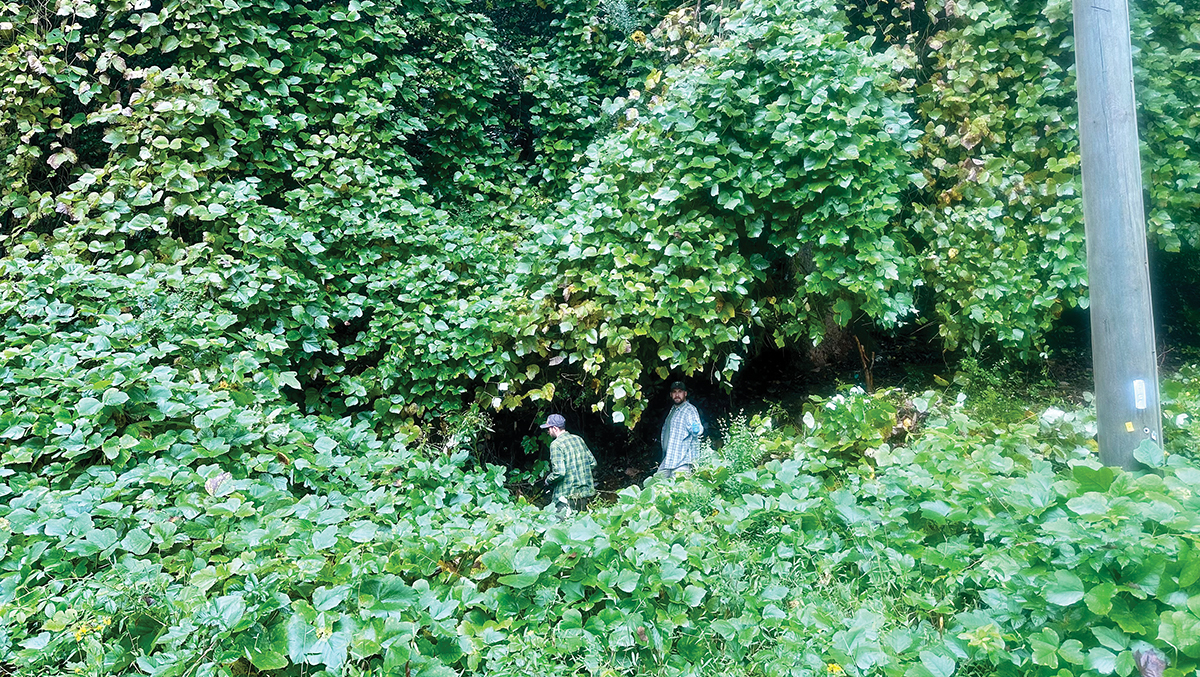
Crew leader Sam Byars, left, and seasonal crewmember Brendan Gilbert in an infestation of kudzu in the Pisgah Ranger District. Photo courtesy of The Pisgah Conservancy
By Emma Castleberry
The Pisgah Conservancy’s Invasive Plant Management Crew is celebrating a successful first year of tackling non-native invasive species in Pisgah National Forest. “The Pisgah is the most visited National Forest in the country and it boasts one of the most biologically rich regions of the country,” says Will Coffee, co-lead of the team. “The beauty and richness of The Pisgah is why so many people are drawn here annually. Invasive plants threaten this wonderful resource, and negative impacts are felt by all who live and recreate here regardless of how they do so. This is why managing the spread of invasive plants is so important.”
Some of the invasive species that threaten the forest’s health include oriental bittersweet, kudzu and Japanese stilt grass, which crowd out native plants and disrupt local ecosystems. Co-lead Sam Byars explains that the problems caused by invasive plants, if left unchecked, will slowly cascade through the ecosystem. “Reduced plant diversity would result in reduced diversity of insects and pollinators,” he says. “Both of these factors would result in lower food quality for larger animals. Forest canopies will be affected by a lower regeneration of native trees, resulting in increased water temperatures that will negatively affect brook trout and aquatic macroinvertebrates. These changes will go relatively unnoticed by most people until it is too late.”
These environmental changes can precipitate an economic threat. “Biodiversity loss would lead to a slow collapse of our billions of tourism dollars and numerous recreation opportunities,” says Coffee. He uses the example of reduced fishing because of trout decline, less habitat for wildlife which means less birding and hunting, and more storm damage to our scenic landscapes. “When our ecosystems are healthy and functioning properly, they act as mitigation tools for drought and deluge,” he says. “All in all, environmental mismanagement and damage, and loss of habitat equals economic loss that reaches the diner owner, the turkey hunter, the hikers and bikers, the birders and—my favorite—the breweries, because you can’t make good beer without clean water.”
The Pisgah Conservancy’s Invasive Plant Management Crew is a partnership program with the US Forest Service that receives support from the Community Foundation of Western North Carolina, Naventure and donors to The Pisgah Conservancy. Coffee and Byars, along with seasonal crewmember Brendan Gilbert, have treated more than 120 acres of infested land and are in the process of surveying an additional 330 acres for treatment. “Specific areas that we will be focusing on are small, uncommon and threatened ecosystems, such as high rock outcrops and mountain bogs,” says Byars. “Other areas that we will be surveying and treating will be high-traffic areas where humans frequently visit. Parking lots, trail heads and campgrounds are often the epicenter of invasive plant infestations, because we unknowingly transport seeds from other areas on our shoes and vehicles.”
The team will also have to address aggressive seedbanks in the project areas where they’ve already removed mature parent plants. “We will be dealing with an abundance of seedlings and some resprouting from extensive root systems,” says Coffee. “This will require a more surgical approach of removal; hand pulling, spot spraying, using a more trained eye to distinguish native seedlings versus invasives.” Byars adds that addressing invasive species effectively requires a multi-year plan. “Complete eradication is impossible at this point,” he says, “therefore sustainable management is our goal.”
Byars also highlights the crew’s ongoing work with the US Forest Service to address areas impacted by Hurricane Helene, which created new opportunities for invasive species to establish themselves in disturbed habitats. He believes that increasing the workforce and continuing partnerships will be essential to effectively managing these areas in the long term.
To support the crew’s efforts, Coffee urges the local community and visitors to take action by volunteering and spreading awareness. “A healthy Pisgah keeps us all going around here,” he says. “We invest blood, sweat and tears in this place, and it gives back tenfold.”
For more information, visit ThePisgahConservancy.org.


